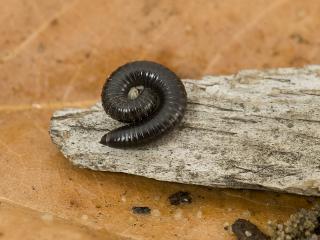Millipedes as pests
Although millipedes play a useful role in breaking down organic matter in the soil, Portuguese millipedes are pests when they reach high population levels.
Portuguese millipedes are not harmful to animals or humans, but they can be a significant domestic nuisance when they invade homes and gardens in their thousands each autumn and spring. They are one of the few millipede species that are attracted to lights at night, and this is presumably why they invade homes. They do not breed inside houses, and once inside a house will probably die. Millipedes can occasionally damage horticultural crops such as melons, strawberries, tomatoes and potatoes, yet in small numbers they do no harm. No damage to broadacre crops has been reported.
Millipede control
Portuguese millipedes are attracted to lights. Turn off external lights which are close to buildings and minimise the escape of light from buildings through use of curtains, blinds and weather-strips on doors. Effective door seals will prevent the entry of these unwanted pests.
Millipedes in the house and garden will probably have resulted from eggs laid within 100m from the house, and while compost is good for gardens, it also allows higher populations of millipedes to develop. Reducing the area covered by organic matter such as compost, leaf litter and mulch, will help reduce millipede populations by diminishing food and areas of shelter.
Biological control
Some spiders, beetles and scorpions will eat millipedes, but these predators do not significantly reduce millipede numbers. They are also parasitised by a nematode and a European fly. Work was under way to establish this fly in South Australia, but the flies were released and never seen again. In 1988 the parasitic nematode, Rhabditis necromena, was released by the Department of Agriculture South Australia in more than 2000 locations in that state. The pest status of the Portuguese millipede has decreased in many areas in South Australia since that time. Rhabditis has been found in millipede populations from the Perth area, and this seems to have provided relief in some areas but will not provide total control. These nematodes attack only millipedes and are active during late autumn and winter. Nematodes may take several years after introduction to reduce millipede numbers, especially in areas adjoining bushland which can support enormous populations of the pest.

